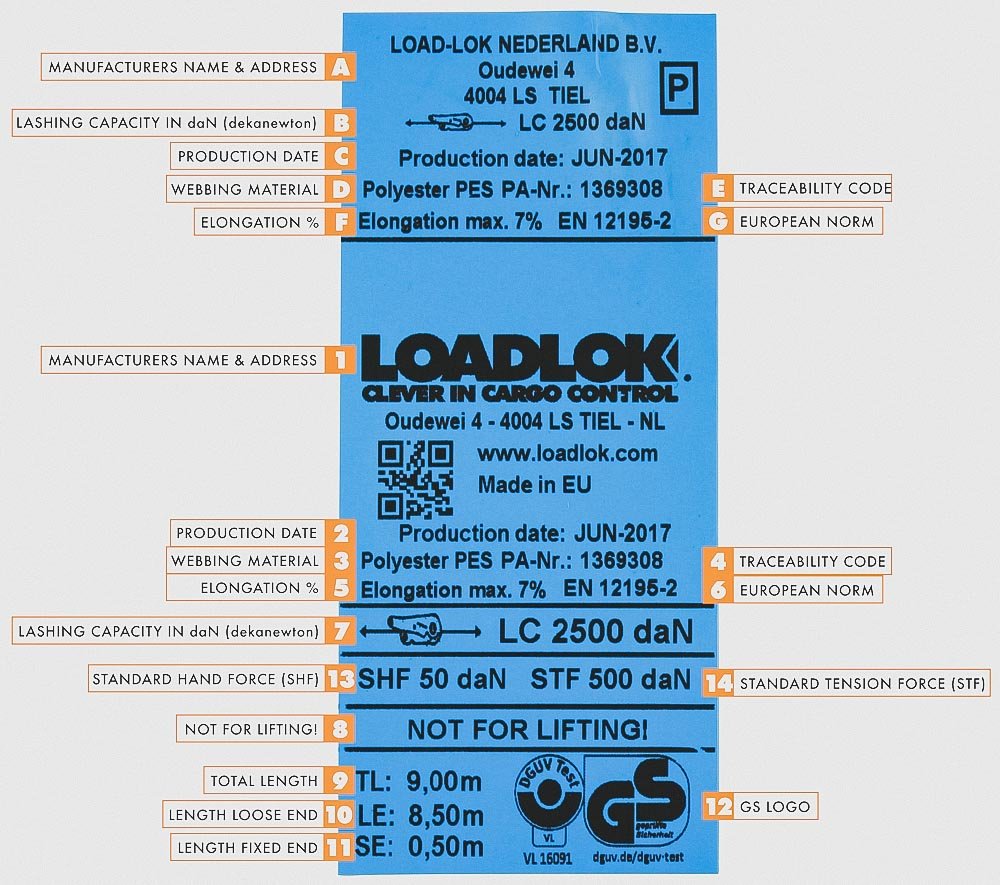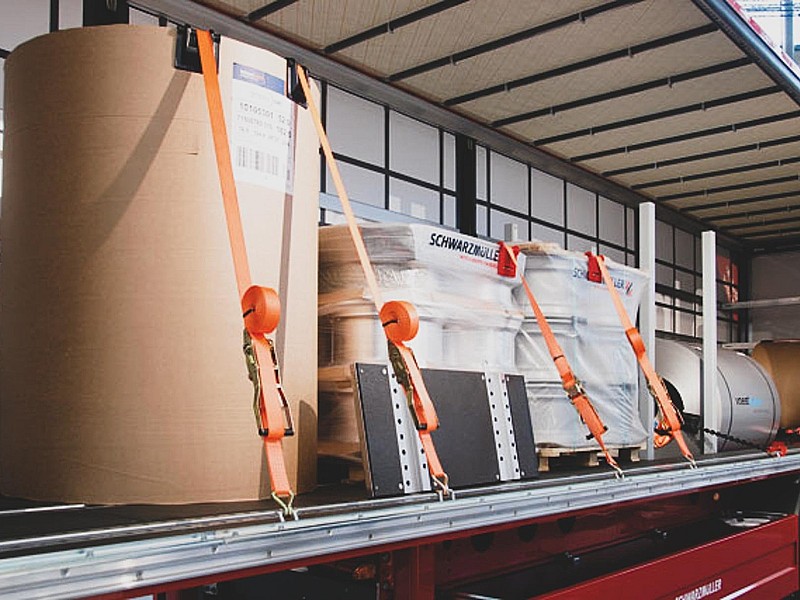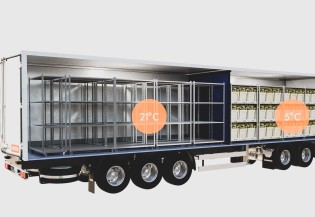This website has been translated with Deepl - the world's most accurate translator
The layout of this label is in accordance with the European norm (EN 12195-2) and can be used as a document to show the authorities or your customers. It is important to know that without this label attached to a strap (or if it is unreadable), you are not allowed to use the strap in any way(!).
If you do not know the meaning of specific terms or numbers on a strap label, we will outline this here. Each of the specific items are marked and explained below.
SECTION INVISIBLE (A/G)
A. Manufacturer’s name + Address
B. LC (Lashing Capacity) Value in daN (decaNewtons)
C. Production Date
D. Webbing Material
E. Traceability Code
F. Elongation %
G. European Norm EN 12195-2

SECTION VISIBLE (1/14)
1. Manufacturer’s name + Address: The name and/or logo of the supplier is mandatory to put on the label so it can, in combination with the traceability code and production date, lead back directly to the manufacturer and batch code. You can find our certificates if you search for 'Cargo Control Company' on DGUV and TÜV SUD websites.
2. Production Date: In combination with the name and/or logo of the supplier and the traceability code, this mandatory date is used to trace products back to the exact production batch.
3. Webbing Material: The webbing material determines the colour of the label. The most used webbing for lashing straps is polyester and label colour is blue.
4. Production Number / Traceability code: In combination with the name and/or logo of the supplier and the production date, this mandatory code is used to trace products back to the exact production batch. With this code, manufacturers can see when the batch was tested and by who, but also which components from which batches were used in the final assembly.
5. Elongation: The maximum elongation for lashing straps according to EN 12195-2 is 7% at LC. Most standard LoadLok straps have an elongation of 5% at LC, allowing a tighter grip on your load!
6. European Norm EN 12195-2: The European Norm EN 12195-2 instructs on the technical parts of load restraint systems for road transport. Part 2 is specifically designed for lashing straps made from manmade fibres and also includes the design of a label.
7. Lashing Capacity in daN (decaNewtons): In load restraint, we talk about forces to withstand rather than weight, therefore, we do not use kilograms but Newton to give the values of the strap. To simplify calculations, we use decaNewtons (daN, 1 daN = 10 Newtons ≈ 1 KGF). The lashing capacity of a strap is determined by the weakest link in the assembly. Please note the Lashing Capacity is NOT USED for tie down lashing, in that case, STF (see 14) should be used.
8. NOT FOR LIFTING! Because the safety factors for lifting equipment differ from the safety factors for lashing equipment, it is absolutely forbidden to use lashing equipment as lifting equipment. For safety reasons, the European Norm requires this statement to be put on all lashing labels.
9. Total length: Total length consists of the length of the fixed/ratchet end and the loose end.
10. Length Loose End: The length of the loose end is the length of the long part with the hook.
11. Length Fixed End: The length of the fixed end is the length of the tensioning device, a part of webbing, and the hook.
12. GS Logo: Certified testing companies like TUV or BG are used to test if the lashing straps are in correspondence with the EN 12195-2 and if correct, will provide you with a GS (Geprüfte Sicherheit) certificate that allows the manufacturer to use the GS logo on the label of the strap. Almost all LoadLok straps come with a GS logo, supplying you with reliable and independently tested materials.
Part 13 and 14 only on fixed end label!
13. Standard Hand Force (SHF): The standard hand force is the force that a ‘standard user’ can apply to the tensioning device/ratchet. In this case, 50daN, is a universal standard and used to determine the STF (see 14.) value of a device in combination with the webbing.
14. Standard Tension Force (STF): The standard tension force is the force created by the SHF and transferred to the webbing. This value is strictly used for tie down lashing. If for example the STF is 500daN and you are tying down your load, the downwards force created on the load is 500daN. The STF is determined by multiple factors. For example, the length of the handle. Please remember, the higher the STF, the fewer lashing straps necessary to secure your load!

Recognising a quality lashing strap
- Check the certificate of the manufacturer online
- The standard norm does not require an expiration date;
- The label requires full address of the manufacturer;
- A strap can never have a CE label! This is strictly forbidden!
If you have any questions concerning your lashing strap label, even if it is NOT a LoadLok lashing strap, do not hesitate to contact us. It is our mission to improve how the world moves cargo. We are happy to help!
The latest in cargo control:
View all items
IsoLok Downloads
Find every download related to IsoLok: User Manuals, Mounting Instructions, Product Information and Brochure.
Read more
Securing cargo with new range of FreightLok Separation & Shoring Nets
As a transport company, you know that ensuring the safety of your cargo is evident —not just for operational efficiency but also to comply with regulations.
Read more